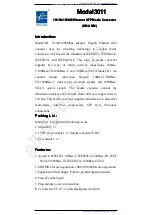
Basic Installation Procedures
975-1057-01-01
42
shorting. See
Recommended Fuse Size on page 27
for
required fuse or breaker size.
3. Open the DC disconnect switch or turn off the DC circuit
breaker.
4. Connect one connector on the POSITIVE (+) cable to the
POSITIVE DC terminal on the inverter/charger, as shown in
Figure 4. The connector goes on first, then the flat washer
(steel), lock washer (steel), and 3/8" (9.52mm) bolt (brass).
5. Connect the other connector to the POSITIVE (+) terminal
on the fuse or breaker. Observe polarity carefully while
completing the installation.
Use a wrench to tighten the bolt to a torque of 11–12 ft-lbs
or 132–144 inch-lbs or 14.9–16.3 Nm at the inverter/charger
end. Observe the fuse holder or breaker manufacturer’s
recommendation at the other end.
6. Connect one connector on the NEGATIVE (–) cable to the
NEGATIVE (–) DC terminal on the inverter/charger, as
shown in
. The connector goes on first,
then the flat washer (steel), lock washer (steel), and 3/8"
bolt (brass).
Figure 5 DC Cable Connections
7. Before proceeding, check that the cable polarity is correct:
POSITIVE (+) on the inverter/charger is connected to the
POSITIVE (+) on the battery, and NEGATIVE (–) cable is
connected to the NEGATIVE (–) terminal on the
inverter/charger.
IMPORTANT
: The next step is the last cable connection you
need to make. A spark is normal when the DC disconnect
switch is turned on or the DC circuit breaker is closed so be
sure step #3 is done before proceeding.
8. Connect the other end of the cable to the NEGATIVE (–)
terminal on the battery.
9. Use a wrench to tighten the bolt to a torque of 11–12 ft-lbs
or 132–144 inch-lbs or 14.9–16.3 Nm at the inverter/charger
end.
Содержание 815-3012-02
Страница 14: ...This page is intentionally left blank 2 ...
Страница 75: ...This page is intentionally left blank 2 ...
















































